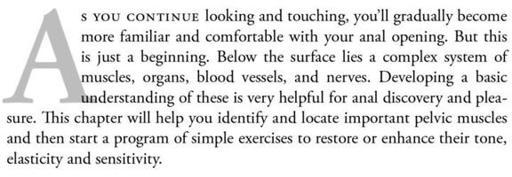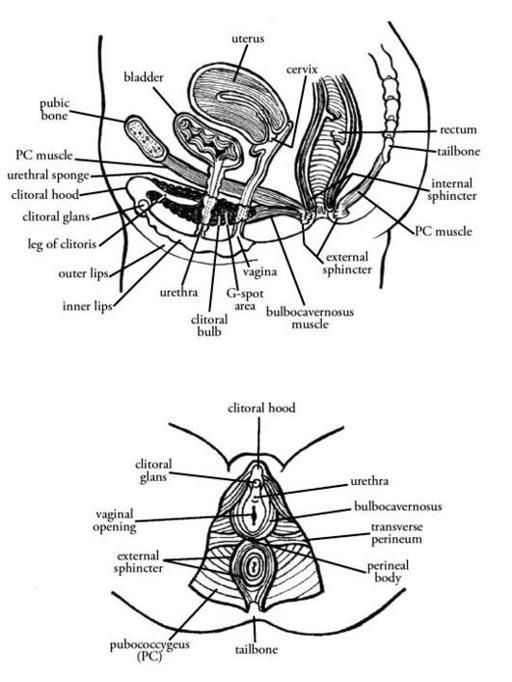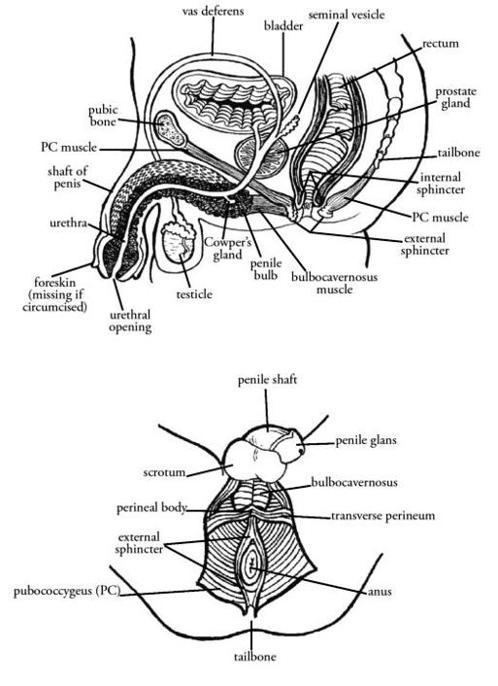Anal Pleasure and Health: A Guide for Men, Women and Couples (10 page)
Read Anal Pleasure and Health: A Guide for Men, Women and Couples Online
Authors: Jack Morin Ph.d.


PERSONIFYING THE ANUS
FEEL FREE TO CHUCKLE, but many of my clients have found it helpful to imagine that their anus has a personality of its own. If you're unaware of your anus and it feels numb, as if it weren't there, you can picture your anus as a stranger whom you need to get to know better. If your anus has been the source of pain and frustration, then your "relationship" has been one of tumult and conflict.
Although this may sound silly at first, it's a useful metaphor. Initially, the goal is for you and your anus to become acquainted. This involves "listening" to what your anus is trying to communicate to you through muscle tension, unpleasant sensations or irritated appearance. It also involves treating your anus with the same respect you would give a friend, protecting it from pain and discomfort, discovering what it needs to be healthy, and willingly changing any behavior to which your anus responds negatively.
People who adopt this perspective usually find that a sense of good will toward the anus is associated with relaxation, an increase in comfort and pleasurable sensations-whereas alienation and hostility breed tension. Once you establish a positive rapport with your anus, you can abandon the idea that you and your anus are separate. Bill said, "Since I've started paying attention to my anus, I've developed a `buddy-buddy' feeling about it. It's the last part of my body I've gotten to know. My connection with myself is now more complete."
The power of tactile and visual self-exploration to counteract the anal taboo becomes increasingly pronounced through repetition. Don't be surprised if it takes a while just to get over the self-consciousness of doing what you may never have done before. Only when self-consciousness gives way to genuine curiosity can you derive maximum benefits. If you can build simplified versions of these looking and touching experiences into your everyday lifelike touching your anus every day in the shower-you will be richly rewarded.





ANATOMY OF ANAL AND PELVIC MUSCLES
YOU'VE PROBABLY HEARD of the anal sphincter-a ring-like muscle that surrounds the anal opening. You may not be aware that there are actually two anal sphincters: the external sphincter and the internal sphincter. As you can see in Figure 2, the two sphincters overlap somewhat.

Figure 2a. Anatomy ofPelvic Organs and Muscles (female)

Figure 2b. Anatomy of Pelvic Organs and Muscles (male)
Knowing that there are two anal sphincters is important because each muscle can, and often does, function independently of the other. As you'll discover, each sphincter is controlled by different neurological mechanisms. For now it's enough to know where these muscles are and that usually they work together; if one is tense, chances are the other is, too.
Other pelvic muscles-collectively called the pelvic floor-support all of the organs and tissues inside the pelvis, including the genitals and the anus. Imagine you're sitting between the legs of a man or woman (the point of view shown in the lower diagrams of Figure 2). Notice the area between the genitals and the anus-the perineum-an extremely sensitive area for most people. If you had X-ray vision and could see the layers of muscles just below the surface, you'd notice that three muscles all come together in this area: (1) the bulbocavernosus (also known as the bulbospongiosus), (2) the transverse perineum, and (3) the upper end of the external anal sphincter. In women, the bulbocavernosus muscle envelops the two interior bulbs of the large clitoral body, and then interconnects with the external anal sphincter. In men, it envelops the bulb (internal end-point) of the penis and then connects to the external anal sphincter.
The late gynecologist Arnold Kegel is famous for his studies of the PC muscle in women. He realized that one function of PC is to help control urine flow (since it surrounds the urethra) and he devised simple exercises to strengthen them in women bothered by "stress incontinence" (involuntary urination when laughing, coughing, running, etc.). Not only did the exercises help to restore urine control, but many of his patients reported welcome side effects from exercising the PC, such as increased sexual sensitivity and responsiveness (Kegel, 1952). These exercises are still often called "Kegels," but I prefer to call them "pelvic exercises" because doing them affects the entire pelvic floor, not just the PC muscle.
In both men and women, the pelvic muscles contract randomly during arousal and rhythmically during orgasm. Improving their condition tends to increase the clarity and intensity of our pelvic erotic sensations. In addition, women and men can deliberately contract or relax their pelvic muscles in order to enhance the pleasure of orgasm or to influence its timing. My clients have found that pelvic exercises improve anal sensitivity as well, because the pelvic floor and the external anal sphincter are intricately connected. When you exercise the pelvic muscles, you're also exercising the anus.
Pelvic exercises build sensitivity in a variety of ways. First, simply doing the exercises focuses our attention and thus enhances our awareness. Second, exercising any muscle increases blood flow into the area and causes a warm tingly feeling, similar to what you may have experienced following a workout or massage. Third, we all know that exercising improves the tone of flabby muscles, and the same goes for the pelvis. Mushy muscles are quite inefficient at transmitting sensations to the nerve endings embedded within them, called proprioceptors, that tell us what's going on inside our bodies. Repeatedly contracting and relaxing muscle fibers builds up their tone and helps them to transmit sensations to the nerve endings more effectively-and pleasurably.
